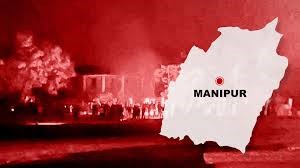Manipur’s Political Crisis And The Way Ahead
Syllabus:
GS-3:
Inclusive Growth, Government Policies & Interventions, Effect of Policies & Politics of Countries on India’s Interests
Why in the News?
On February 13, 2025, Article 356 was invoked in Manipur, placing the State under President’s Rule. This move transferred administrative and legislative functions to the President of India, suspending the State government but keeping the Assembly in “animated suspension” rather than dissolving it. The decision is seen as a means to give the ruling BJP time to reconcile internal differences and regain power instead of conducting fresh elections.
Factors Leading to President’s Rule
- Prolonged anarchy: Manipur faced lawlessness for 20 months since the communal violence on May 3, 2023, yet the Union government hesitated in invoking Article 356.
- Article 174 constraint: The six-month deadline between Assembly sessions expired on February 12, since the winter session was skipped and the Budget session scheduled for February 10 was disrupted.
- Chief Minister’s resignation: On February 9, N. Biren Singh resigned under pressure from BJP’s central leadership to prevent an internal party split amid rising dissent.
- Governor’s action: Governor Ajay Kumar Bhalla declared the Assembly session scheduled for February 10 as “null and void”, possibly unaware of the constitutional deadline or expecting a new Chief Minister to take charge.
- Political deadlock: Intense rivalry between Biren Singh loyalists and dissidents over his successor led to a governance vacuum, making President’s Rule inevitable.
Manipur’s Political Instability and Ethnic Diversity
- Frequent President’s Rule: This marks Manipur’s 11th instance of President’s Rule, highlighting its vulnerability to political crises.
- Ethnic fragmentation: The State’s complex demographics include 33 Scheduled Tribes, primarily Nagas and Kuki-Zos, alongside Meiteis, Meitei Muslims (Pangals), and non-tribal groups like Nepalis, Punjabis, Tamils, and Marwaris.
- Invisible minorities: Non-tribal communities are politically marginalized, despite constituting a significant portion of the 3-million-strong population.
- Populist politics: Competitive ethnic mobilization and sectarian populism have deepened political instability, making governance difficult.
- Recurring ethnic conflicts: The recent Meitei-Kuki-Zo conflict has intensified political divisions, making governance a complex challenge.
Populism and its Political Impact
- Reordering populism: Seeks broad restructuring of the moral order, often leveraging poverty alleviation or farmer rights for political gains but tending toward majoritarianism and authoritarianism.
- Additive populism: Focuses on inclusion of excluded groups rather than a radical overhaul, such as demands for Nepali representation in Manipur’s politics.
- Quotidian populism: Aims to create and preserve exclusive constituencies, reinforcing polarization and partisan politics to maintain power.
- Populism in Manipur: The Biren Singh government’s policies, such as anti-forest encroachment and poppy eradication, were framed as moral imperatives but executed in a way that alienated the Kuki-Zo tribes.
- Ethnic paranoia: Both the BJP leadership and opposition elites exploited ethnic anxieties for their respective political benefits, turning administrative actions into communal strife.
The Fight that Escalated
- Origins of conflict: The government’s drive against forest encroachment, poppy cultivation, and illegal migration disproportionately affected Kuki-Zo tribes, creating a sense of victimization.
- Insensitivity in execution: Policies were implemented with accusatory populism, dehumanizing those impacted and exacerbating ethnic divisions.
- Ethnic polarization: Both sides engaged in competitive populism, further deepening the Meitei-Kuki-Zo divide.
- Political opportunism: Instead of addressing grievances constructively, leaders used ethnic narratives for political leverage.
- Transformation into communal hostility: What began as an administrative crackdown evolved into full-scale communal enmity due to populist rhetoric.
Challenges Ahead
- Short-lived President’s Rule: The BJP is likely to reclaim power soon, but political reconciliation remains uncertain.
- Managing border movements: Cross-border migration must be regulated rather than completely blocked, acknowledging Manipur’s historical demographic shifts.
- Sustainable reforms: Forest conservation and anti-drug policies should be continued, but executed with sensitivity to prevent further alienation of communities.
- Ending communal hostilities: Trust-building measures must replace polarizing politics to restore stability.
- Consensus-driven governance: Moving beyond populism, the focus should be on inclusive policies that serve the greater common good.
Towards a Common Good Politics
- Beyond populism: Manipur’s politics must transition from divisive populism to consensus-building.
- Promoting inclusivity: Governance should ensure representation of all ethnic and non-tribal communities.
- Accountable leadership: Political stability can only be achieved if leaders prioritize policy over identity politics.
- Merit over identity: Manipur’s political history shows that any capable leader, regardless of ethnicity, can become Chief Minister.
- Sustained peace efforts: The State’s future depends on dialogue, inclusivity, and governance that prioritizes collective well-being.
Conclusion
Manipur’s current political crisis underscores the dangers of populism-driven governance. A return to inclusive, common-good politics is essential for stability, progress, and inter-ethnic harmony. President’s Rule should serve as a corrective phase, ensuring a more consensual approach to governance moving forward.
Mains Practice Question
Analyze the constitutional and political factors leading to President’s Rule in Manipur. Discuss the role of populism in aggravating ethnic tensions and suggest measures to promote stable and inclusive governance.





